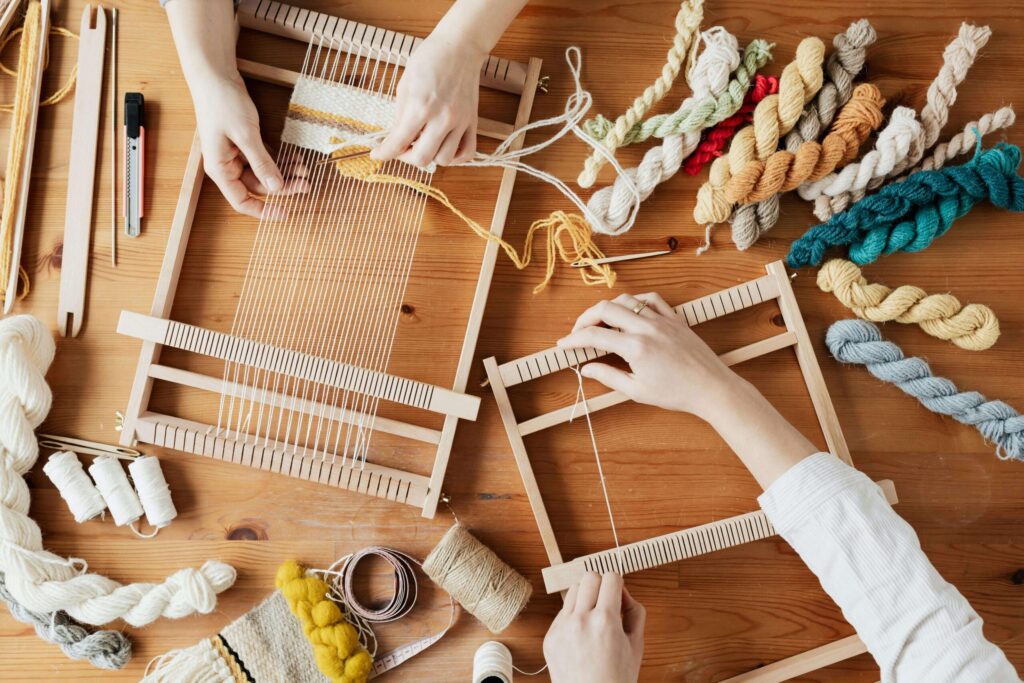Selling handmade crafts online is a serious business opportunity this year. What was once just a trendy side hustle has now become a full-blown career path for thousands of creative entrepreneurs around the world.
With more shoppers craving authentic, unique items over mass-produced goods, you’re entering a thriving market at exactly the right time. In fact, according to Etsy’s 2024 Spring and Summer Trends report, there was a +238% year-over-year increase in searches for “handmade gifts.”
But like accessible opportunity, there’s a catch. Choosing where to sell handmade crafts online can make or break your success. I’ve seen it firsthand with my own clients. Some doubled their sales just by switching platforms, while others struggled because they didn’t pick the right one from the start.
-
Choosing the best platform to sell handmade crafts online depends on your goals, budget, and how you want to grow your brand.
-
Etsy offers fast exposure with a built-in audience, while Shopify gives you full control and long-term branding power.
-
Amazon Handmade works well for sellers with mainstream appeal, while GoImagine and Artisans Cooperative support mission-driven makers.
-
Starting with a combination like Etsy and Shopify helps you balance quick sales with future growth and independence.
-
The most important step is to stop hesitating and get your handmade business in front of the right buyers today.
The right platform will put your products in front of buyers and help you build your brand, protect your margins, and support your long-term growth. It’s like finding a long-term home for your business where you can thrive.
In this guide, I’ll introduce the best platforms to sell handmade crafts online and provide a few insider tips I’ve learned from working with dozens of craft-based entrepreneurs who turned their passion into serious profit. Let’s dive in.
Why Choosing the Right Platform Matters
Choosing the best platform to sell handmade products lays the foundation for how your business performs, whether you’re making steady sales, building repeat customers, or scaling into something bigger over time.
Each platform draws a specific type of shopper. Etsy buyers, for example, are usually on the hunt for meaningful, artistic gifts, something that feels one-of-a-kind. Amazon Handmade customers lean more toward speed and convenience. They still want quality, but they expect fast delivery and a polished buying experience backed by Prime.
If your products match the vibe of a platform’s audience, you’ll naturally gain traction. If not, you could end up spending hours perfecting your listings, only to get overlooked by the wrong crowd.
I’ve worked with sellers who saw their profits dip just because they stayed too long on a platform that didn’t match their brand. Others saw huge growth after switching, not because their product changed, but because they finally got in front of the right audience.
Picking the wrong platform can cost you visibility, eat into your margins with hidden fees, and slow your momentum. Choose wisely, and you’re setting yourself up for the kind of growth that lasts.
Best Platforms to Sell Handmade Crafts Online
So, where should you sell your handmade products online in 2025? Different sites work better depending on your goals, your style, and how much time you’re willing to invest in growth.
1. Etsy

When you think about handmade marketplaces, Etsy is probably the first name that comes to mind, and for good reason. Etsy built its reputation on celebrating handmade, vintage, and one-of-a-kind products. Today, it remains one of the most trusted spaces for buyers who are looking for special, personal gifts.
Etsy offers a massive built-in audience of approximately 89.6 million as of late 2024. It’s easy to set up a shop and Etsy carries a trusted reputation among handmade and vintage buyers. However, sellers face high competition, transaction fees of 6.5% plus a $0.20 listing fee per item, and optional promoted listings that can drive up costs.
Etsy is best suited for jewelry makers, artists, home decor creators, and vintage sellers. One of my clients, a jewelry designer, grew her sales by 280% just by learning how to optimize Etsy SEO—using strong keywords like “minimalist handmade jewelry” and “custom birthstone necklace.”
It wasn’t about spending more money; it was about understanding how buyers actually search. On Etsy, the sellers who master search optimization are the ones who stand out, even in a crowded space.
Here’s a tip: Use long-tail keywords like “handmade birthday gifts for her” in your product titles and tags to increase your visibility where it matters most.
2. Shopify
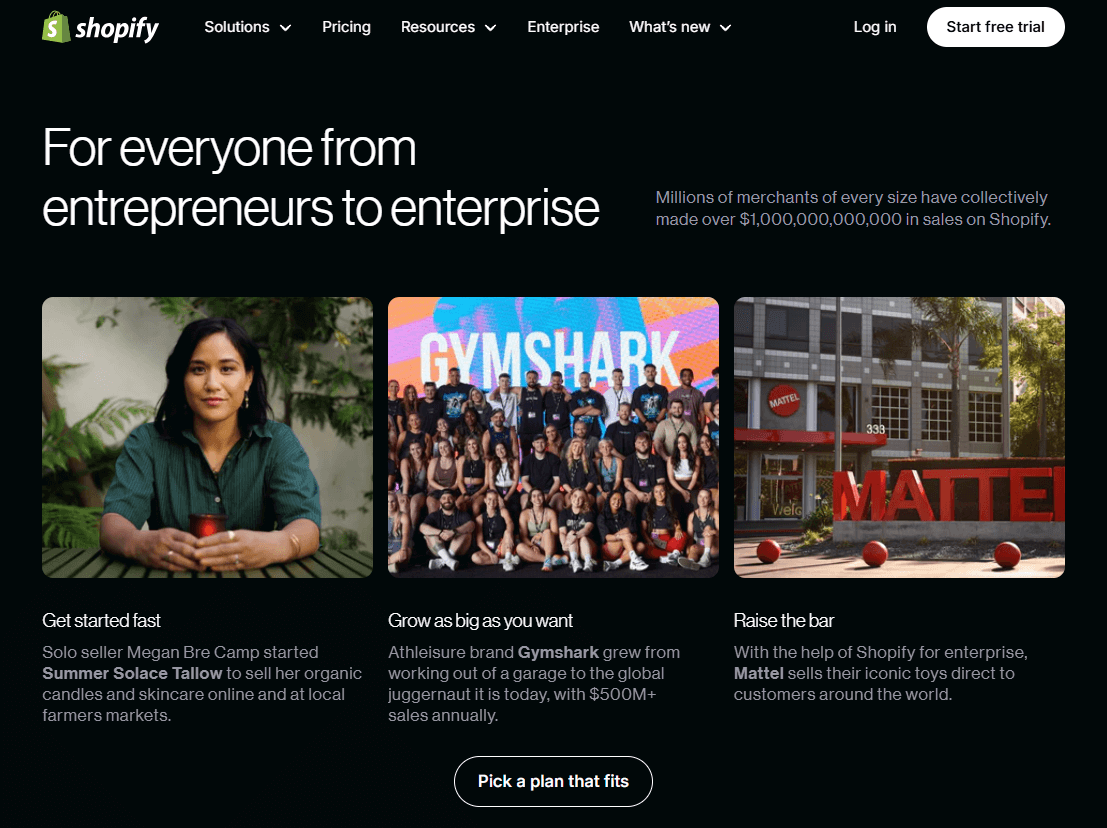
If you’re serious about building your own brand from the ground up, Shopify is hands down one of the best platforms to sell crafts online. It gives you freedom to design your store exactly how you want and build a direct relationship with your customers. Shopify offers full control over your store’s branding, layout, and customer experience.
It also provides built-in tools for SEO, email marketing, and abandoned cart recovery, plus seamless integration with Instagram, Facebook, and TikTok. The downside is that there’s no built-in audience—you’ll need to drive your own traffic—and there are monthly costs starting at $39, plus potential app fees depending on how much functionality you want.
Shopify is best for sellers ready to invest in their brand and marketing. A crochet shop owner I worked with made the switch from Etsy to Shopify last year. She had gorgeous products but felt invisible on Etsy. After moving to Shopify, she started collecting emails, running flash sales through Instagram Stories, and hosting live shopping events.
In just six months, she doubled her revenue. The difference wasn’t luck but ownership. When you own your platform, you have the power to control your marketing, your customer experience, and your future growth.
Think of Shopify like buying land to build your house, while Etsy is renting an apartment with lots of neighbors. Both have value. It all depends on how much you want to control your space.
3. Amazon Handmade
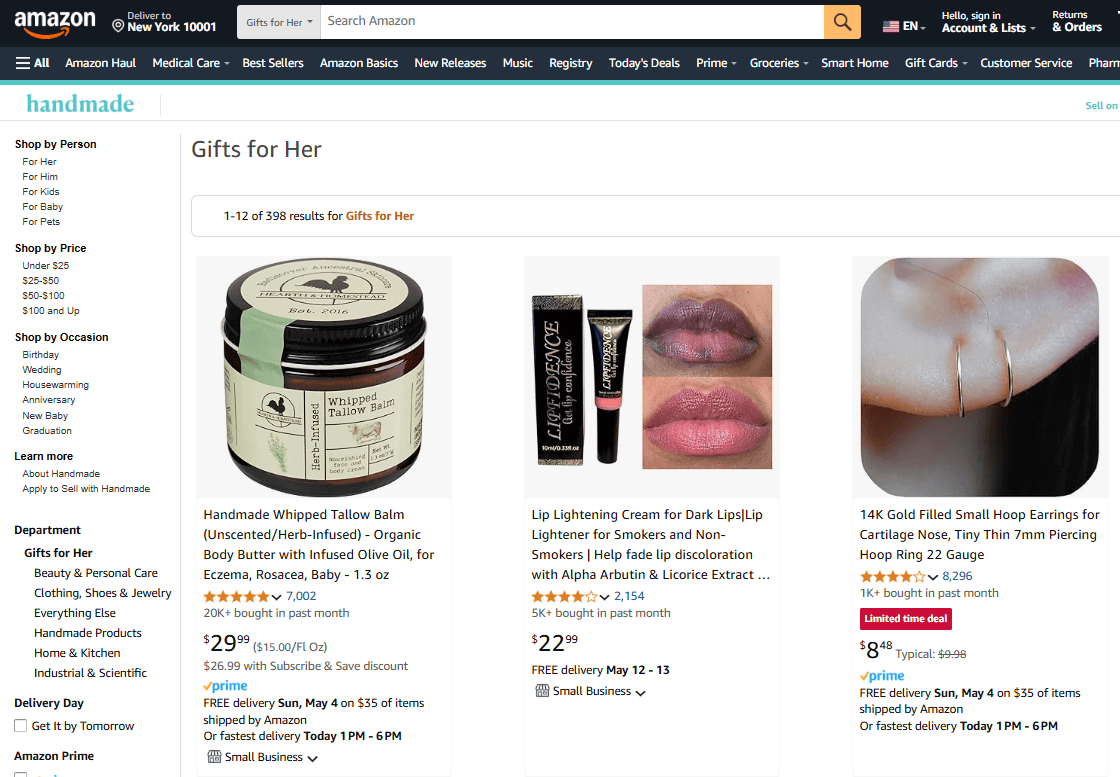
Amazon Handmade offers global reach with the trust factor of Amazon’s brand. If you want access to millions of shoppers who already trust the platform with their wallets, this is a strong choice.
Sellers can tap into Prime buyers who tend to buy faster and more frequently, reach Amazon’s massive customer base of over 300 million active users globally, and let Amazon handle taxes and payment processing.
However, there’s a strict application process to get accepted, a 15% referral fee, and less opportunity to personalize your brand compared to your own store. Amazon Handmade is best for handmade goods that can appeal to mainstream shoppers. Think leather goods, wooden toys, kitchenware.
If your handmade crafts fit popular categories and can benefit from fast shipping, Amazon Handmade can massively boost your exposure without needing heavy marketing on your side.
4. GoImagine

GoImagine markets itself as the “marketplace that cares,” and it’s quickly earning respect among artisans who want their business to have a deeper impact. Sellers on GoImagine contribute to a platform where 100% of profits go to children’s charities.
It offers low fees, ranging from $2.50 to $10 per month, plus a 5% transaction fee. The community is smaller and more supportive compared to Etsy or Amazon, but that also means a smaller buyer base. GoImagine is best suited for sellers who value social impact and community.
One of my handmade soap sellers moved her side hustle here because she loved the idea that her work could also contribute to a greater cause. She noticed something interesting: customers seemed more invested, not just in her products, but in her story.
Some were willing to pay higher prices because they valued the mission behind the brand. GoImagine proves that meaningful values can attract serious buyers.
5. Big Cartel

Big Cartel is simple, budget-friendly, and perfect for artists and beginners who want to get their first products online without a complicated setup. The platform offers a free plan for up to 5 products, an easy setup without tech headaches, and no transaction fees.
However, it has limited features unless you upgrade to a paid plan, and customization options are basic. Big Cartel is best for new sellers testing the waters. If you’re feeling overwhelmed by complex store builders, Big Cartel lets you skip the learning curve and start selling right away.
I often recommend it to beginners who want to launch quickly without spending much upfront. Think of it like getting a booth at a local craft fair: small, simple, but enough to get you seen.
6. Artisans Cooperative
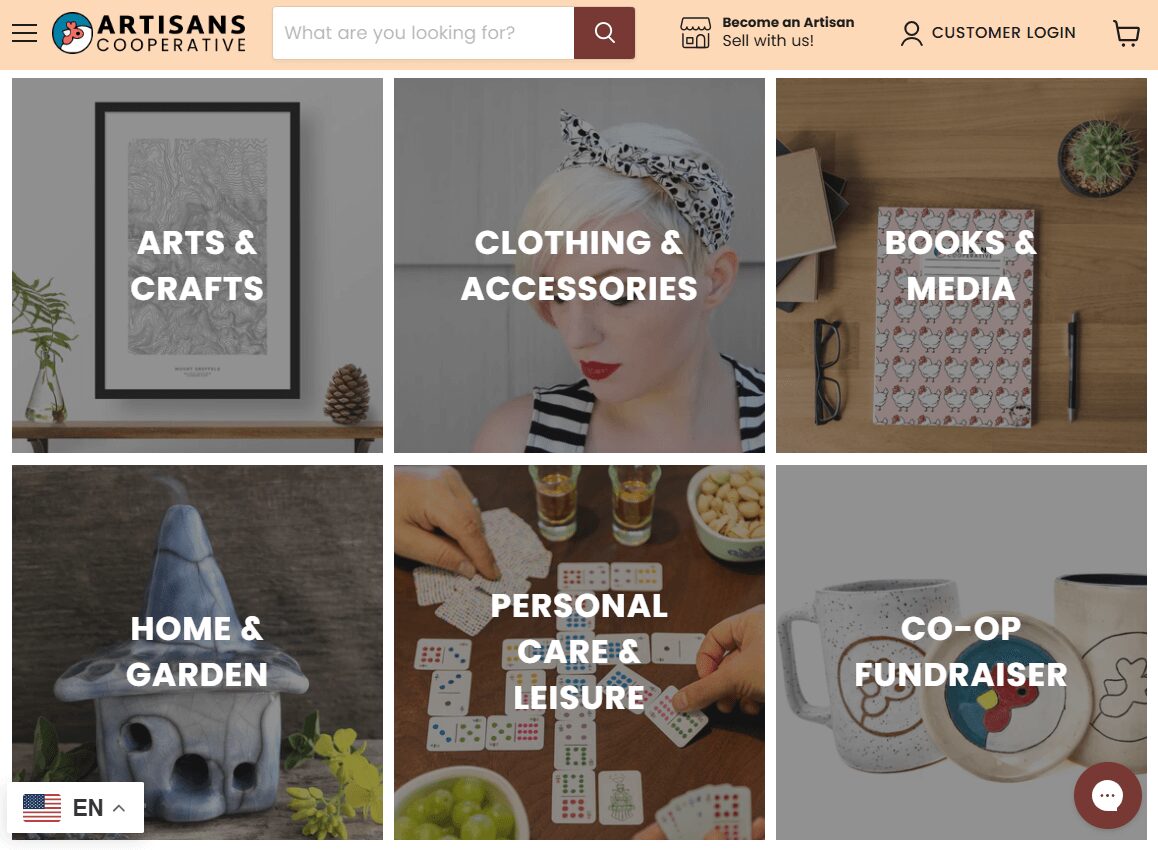
This newcomer is shaking things up. Artisans Cooperative is run by sellers, for sellers, putting creative control back where it belongs. Sellers join a cooperative model where they have a say in major decisions.
The platform offers transparent fees and governance and is focused purely on handmade items, steering clear of mass-produced goods. The downside is a smaller buyer base (at least for now) and the fact that the platform is still evolving.
Artisans Cooperative is best for sellers who want community over corporate control. As one artisan said, “Selling on Artisans Cooperative feels like coming home, not just renting a booth.”
That feeling of belonging can be powerful, especially when you’re trying to build a sustainable craft business surrounded by like-minded creators.
7. Bonanza
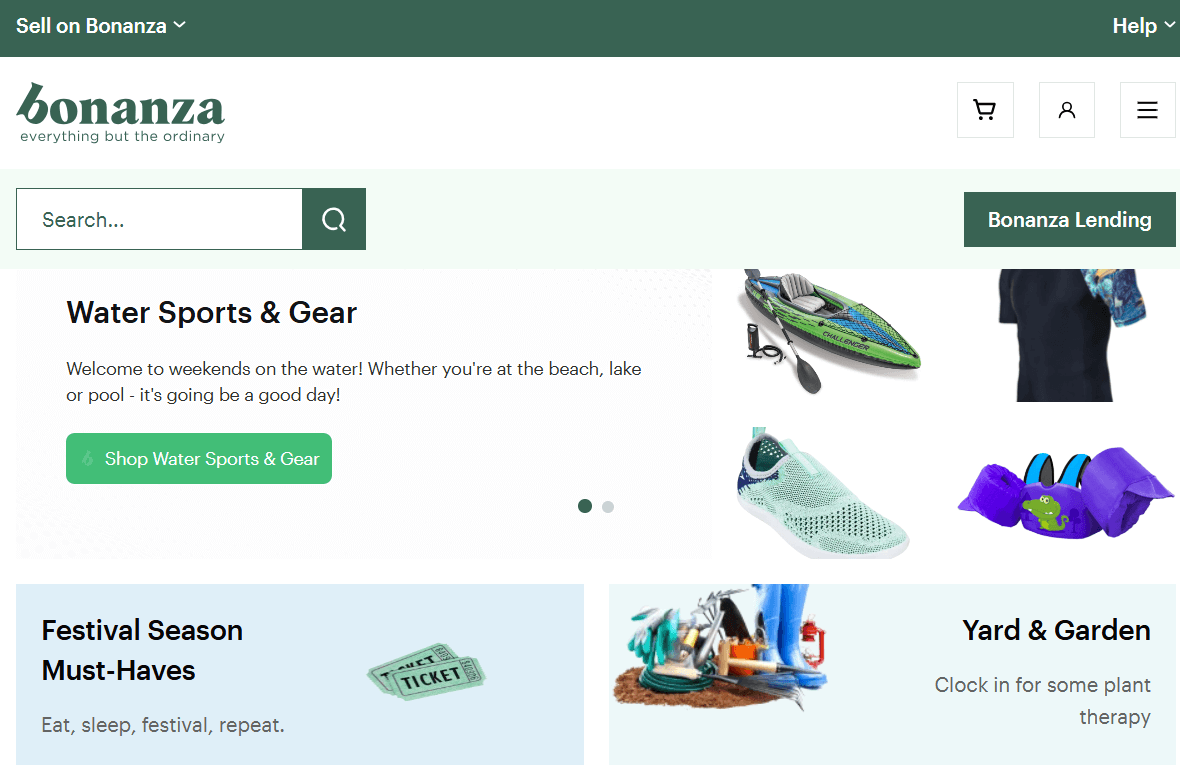
If you want less competition and more SEO muscle, Bonanza deserves a serious look. It’s a lesser-known platform, but one with plenty of potential if you’re willing to invest a little effort into promotion.
Bonanza allows you to import listings from Etsy, Amazon, or eBay, and it’s highly SEO-friendly, helping your products rank on Google search results. It also offers low fees, taking only 3.5% of your final sale price. However, the traffic is lower compared to Etsy or Amazon.
Bonanza is best for sellers who want to diversify their sales channels. Many of my clients use Bonanza as a secondary shop to pick up extra customers from Google without having to constantly hustle on social media.
8. Facebook & Instagram Shops
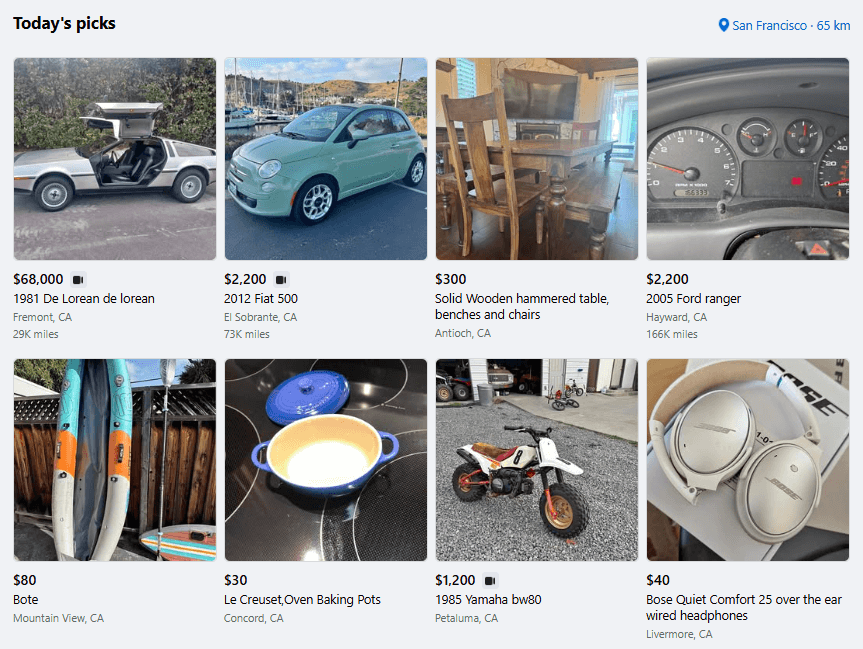
With Facebook and Instagram Shops, you can sell handmade products online directly to your social followers without making them leave the app. You get access to massive audiences, a seamless checkout process, and a perfect setup for impulse buys through Stories and Reels.
The catch is that you’ll need consistent social media marketing to keep traffic flowing, and serious scaling might require ad spend. Facebook and Instagram Shops are best for sellers who already have engaged followers or the skills to build a community.
Facebook Marketplace reported over 1 billion monthly users in 2024, making it one of the biggest untapped markets for craft sellers. If you’re active on Instagram or Facebook, setting up Shops could mean turning likes and comments into actual sales without needing a full website yet.
Comparison Table: Handmade Selling Platforms (2025)
Choosing the best platform to sell handmade crafts online depends on what you value most—whether it’s audience size, fees, branding control, or community support. To help you weigh your options quickly, here’s a side-by-side comparison of the top handmade selling platforms in 2025.
This snapshot gives you a clear view of listing fees, transaction fees, traffic levels, and who each platform serves best.
Platform Listing Fees Transaction Fees Best For Traffic Level Custom Branding
Etsy $0.20 6.5% + payment General handmade sellers High Low
Shopify None Payment gateway Brand builders User-driven High
Amazon Handmade None 15% referral fee Mass-market handmade Very High Medium
GoImagine $2.50–$10/month 5% Mission-driven sellers Low-medium Medium
Big Cartel Free–$9.99 None New sellers Low-medium Medium
Artisans Cooperative Varies Varies Community-focused sellers Low Medium-high
Bonanza None 3.5% Multi-platform sellers Medium Medium
Facebook/Instagram None 5% or $0.40/order Social media-savvy sellers High Medium
How to Choose the Best Platform for Your Handmade Business
Choosing the best platform for your handmade business means thinking about what fits your products, your brand, and the way you want to grow.
It’s not about picking the most popular site. It’s about picking the right home for what you create. Here’s a quick checklist to guide you:
If you want full control over your store’s look, customer experience, and marketing, choose Shopify. It’s ideal for building a strong brand from scratch and gives you the tools to scale over time.
If you need instant exposure and want to get in front of active shoppers right away, Etsy or Amazon Handmade are smart picks. They already have the audience. You just need to show up well.
If you’re mission-driven and want your business to have a deeper meaning beyond sales, GoImagine or Artisans Cooperative are strong choices. These platforms attract buyers who care about community and values, not just products.
If you’re on a tight budget and want something simple to get started, Big Cartel or Bonanza let you open a shop without a heavy investment. They’re perfect if you want to dip your toes into selling without risking too much upfront.
If you’re social media savvy and already have an audience hanging out on Instagram or Facebook, Facebook & Instagram Shops can help you turn your followers into buyers. Selling where your audience already spends time can lead to faster growth without needing a full website right away.
Still unsure? You’re not alone. Many successful handmade sellers I’ve worked with actually start with two platforms, like Etsy plus Shopify. Etsy helps you make quick, steady sales, while Shopify lets you slowly build a brand that stands on its own.
Covering both immediate revenue and long-term growth gives you more security and more opportunities as your business evolves.
Which Platform Should You Choose?
Honestly? There’s no “perfect” platform. Every marketplace has strengths, weaknesses, and its own rhythm. In my opinion, the best platform to sell handmade crafts online in 2025 is the one that matches your bigger goals, not just your products.
Where you decide to sell should reflect where you want your business to go next year, the year after that, and beyond.
If you’re serious about building a brand that people remember, where customers come back again and again because they trust you, start with Shopify or a Shopify + Etsy combo. Shopify gives you control, branding freedom, and long-term growth, while Etsy helps you tap into a steady flow of buyers right away.
This two-platform approach has worked wonders for several sellers I’ve helped—building quick momentum with Etsy while laying the foundation for their own store with Shopify in the background.
If you simply want to make some extra income selling your crafts with less hassle, Etsy is still king. It’s familiar, easy to set up, and buyers trust it already. You don’t have to worry about building a website or running paid ads from day one.
You focus on making beautiful products, optimizing your listings, and letting Etsy’s search engine help you find your first wave of customers.
But if you believe your work is part of a bigger mission—if you create because it’s tied to something you deeply care about—then GoImagine or Artisans Cooperative might be where your heart (and your profits) belong.
These platforms aren’t about mass selling. They’re about meaning. They connect you with buyers who want their dollars to support more than just another transaction. They want to be part of a bigger story, and your craft could be exactly what they’re looking for.
No matter which road you take, the biggest mistake is waiting too long. The buyers are already out there, scrolling, searching, and ready to support creators like you. It’s time to meet them halfway, put yourself out there, and start building the kind of business you’ll be proud of a year from now.

